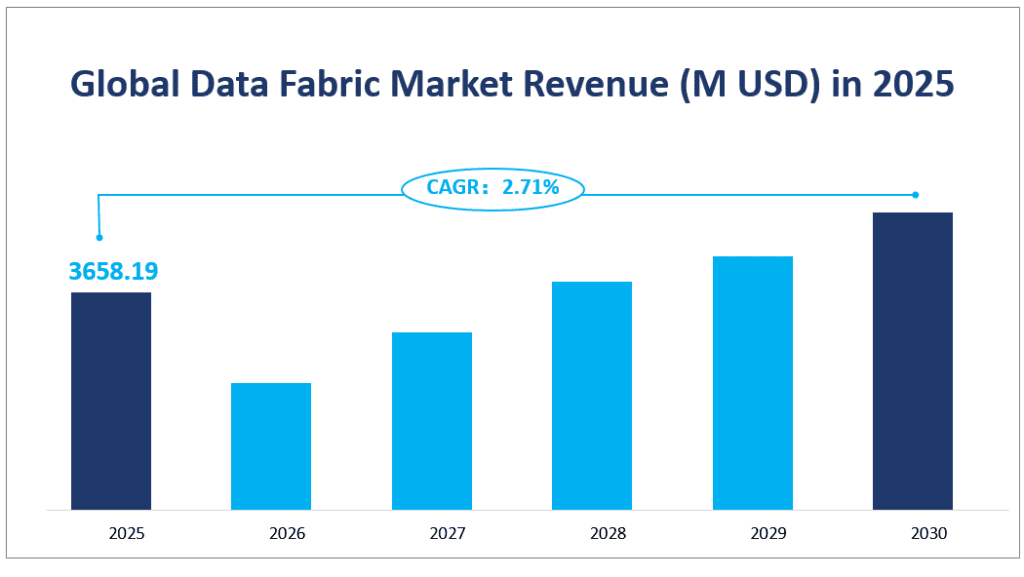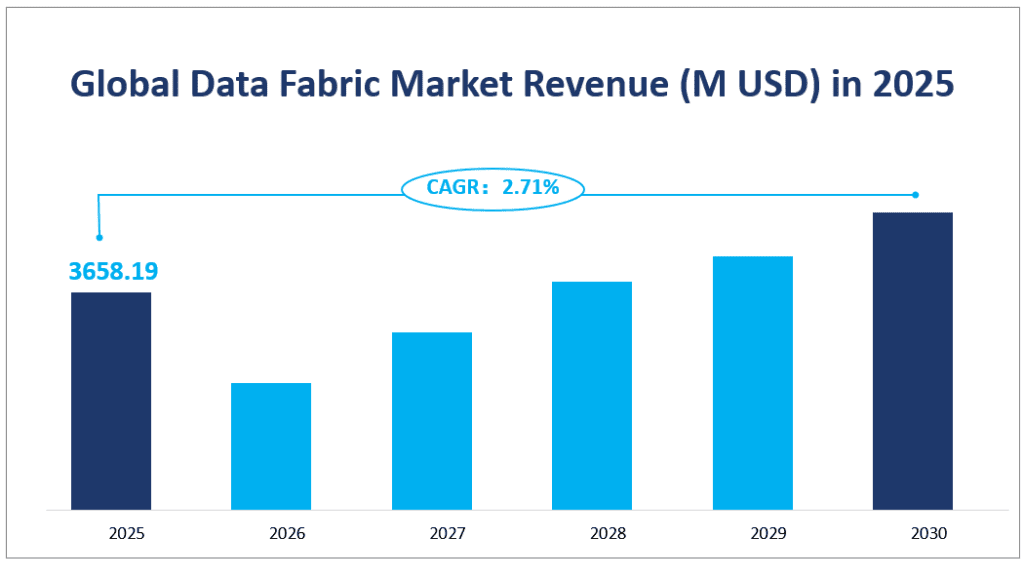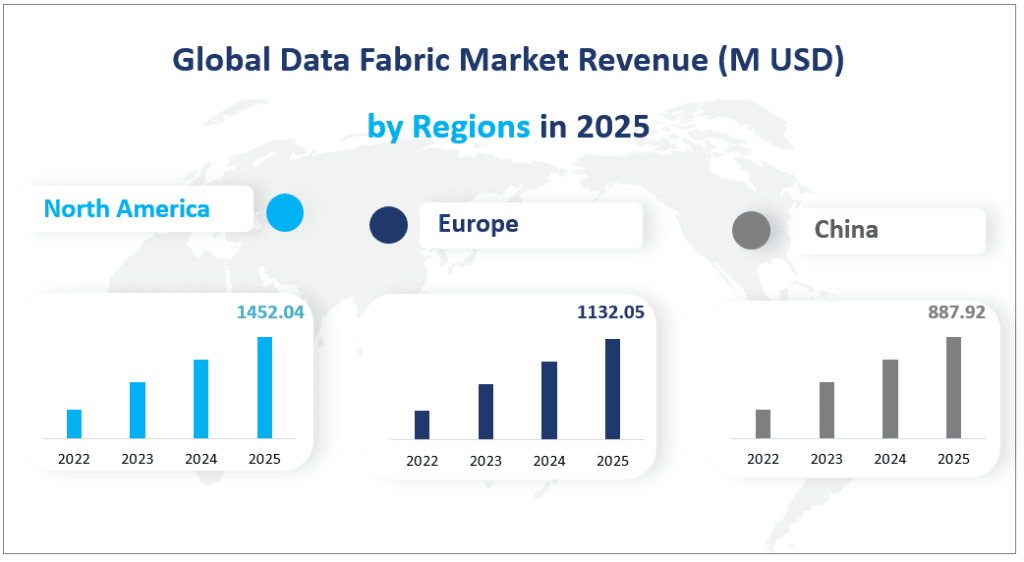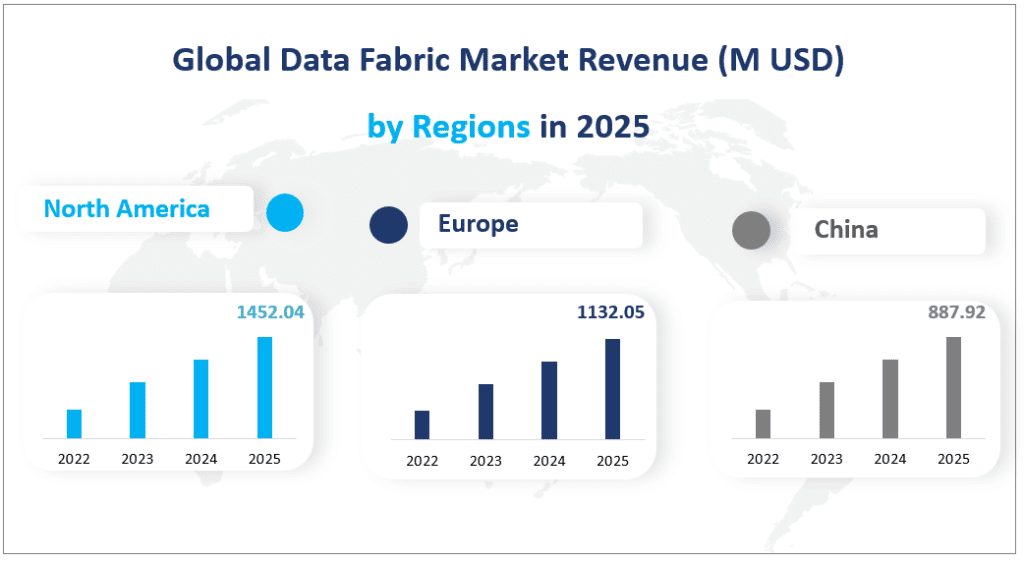1. Global Data Fabric Market Value and Growth
The global Data Fabric market value will reach $3,658.19 million with a CAGR of 2.71% over the forecast period from 2025 to 2030. This rapid expansion underscores the increasing demand for data integration and management solutions across various industries, as organizations strive to optimize their data assets and enhance operational efficiency.
Data Fabric is an innovative and comprehensive solution designed to address the complex challenges of modern data management. It integrates architecture, data management, and integration software to provide a unified, consistent user experience and access to data, regardless of the location or platform where the data is stored. This end-to-end solution enables organizations to manage their data more effectively, ensuring seamless access and sharing in a distributed data environment.
Global Data Fabric Market Revenue (M USD) in 2025


2. Driving Factors of the Data Fabric Market
Increasing Demand for Data Integration: As organizations continue to generate and collect vast amounts of data from various sources, the need for effective data integration solutions has become paramount. Data Fabric provides a seamless way to integrate data from different platforms and applications, ensuring that organizations have a unified view of their data assets.
Rise of Digital Transformation: The ongoing digital transformation across industries has led to a greater reliance on data-driven decision-making. Data Fabric enables organizations to manage their data more efficiently, supporting initiatives such as cloud migration, analytics, and artificial intelligence. This, in turn, drives innovation and enhances overall business performance.
Growing Complexity of Data Environments: Modern data environments are characterized by a mix of on-premise and cloud-based systems, as well as a variety of data types and formats. Data Fabric’s ability to manage this complexity and provide a unified data management framework is a significant driver of its adoption.
Enhanced Data Governance and Security: With increasing regulatory requirements and concerns over data privacy, organizations need robust data governance and security measures. Data Fabric incorporates advanced security protocols and governance capabilities, ensuring that data is protected and compliant with relevant regulations.
Cost Efficiency: Data Fabric solutions often offer cost-effective alternatives to traditional data management approaches. By automating key processes and reducing the need for manual intervention, organizations can achieve significant cost savings while improving data management efficiency.
3. Limiting Factors of Data Fabric Market
Technical Complexity: Implementing a Data Fabric solution requires a high level of technical expertise and infrastructure. Organizations may face challenges in integrating Data Fabric with their existing systems, particularly if they lack the necessary technical resources or experience.
Data Security Concerns: While Data Fabric offers advanced security features, the increasing sophistication of cyber threats poses a significant risk. Organizations may be hesitant to adopt Data Fabric solutions due to concerns over data breaches and the potential loss of sensitive information.
Regulatory Hurdles: The regulatory landscape for data management is constantly evolving, with new laws and regulations being introduced regularly. Compliance with these regulations can be complex and time-consuming, potentially delaying the adoption of Data Fabric solutions.
High Initial Costs: The initial investment required to implement a Data Fabric solution can be substantial, particularly for smaller organizations. This may create a barrier to entry, limiting the market’s growth potential in certain segments.
Market Fragmentation: The Data Fabric market is highly fragmented, with numerous vendors offering a wide range of solutions. This can make it difficult for organizations to choose the right solution, leading to decision paralysis and delays in adoption.
4. Analysis of the Data Fabric Market Segment
Product Types
The Application (Software) segment is expected to hold the largest market share, accounting for approximately 78.20% with a market value of $2860.64 million in 202. This segment includes cloud-based and on-premise solutions, which are increasingly being adopted by organizations to manage their data more efficiently and effectively.
The Service segment, while smaller in comparison, is also a significant part of the Data Fabric market. It includes consulting, deployment, and maintenance services that support the implementation and operation of Data Fabric solutions. By 2025, the service segment is projected to hold a market share of 21.80% with a market value of $797.55 million.
In terms of growth rates, the Application (Software) segment is expected to grow at a slightly faster pace. This indicates that while both segments are growing rapidly, the application segment is slightly outpacing the service segment in terms of growth.
Analysis of Data Fabric Market by Applications
Among these segments, Large Enterprises are expected to hold the largest market share, accounting for approximately 42.23% of the total market value. Large enterprises typically have more complex data management needs and are more likely to invest in advanced Data Fabric solutions to optimize their operations and drive digital transformation.
Medium Enterprises are also significant contributors to the market, with a projected market share of 35.32% by 2025. These enterprises are increasingly adopting Data Fabric solutions to enhance their data management capabilities and stay competitive in the market.
Small Enterprises are expected to hold a market share of 22.34% by 2025. While smaller in size, these enterprises are also adopting Data Fabric solutions to improve their data management processes and leverage the benefits of digital transformation.
In terms of growth rates, Small Enterprises are projected to grow at the fastest pace. This growth is driven by the increasing awareness of the benefits of data management and the availability of cost-effective solutions tailored for small businesses.
Market Value and Share by Segment
| Market Value (M USD) in 2025 | Market Share in 2025 | ||
| By Type | Application | 2860.64 | 78.20% |
| Service | 797.55 | 21.80% | |
| By Application | Small Enterprises | 821.28 | 22.45% |
| Medium Enterprises | 1291.95 | 35.32% | |
| Large Enterprises | 1544.96 | 42.23% |
5. Regional Data Fabric Market
Among these regions, North America is expected to hold the largest market value with $1452.04 million in 2025. This region’s dominance is attributed to the high adoption rate of advanced technologies, robust IT infrastructure, and a significant number of early adopters of Data Fabric solutions.
North America, particularly the United States and Canada, is at the forefront of technological innovation. The region has a high concentration of technology companies and research institutions, driving the development and adoption of advanced data management solutions. The region boasts a well-developed IT infrastructure, which supports the deployment and operation of sophisticated Data Fabric solutions. This infrastructure enables organizations to leverage the full potential of Data Fabric technologies.
Europe is projected to have a market value of $1132.05 million by 2025. European enterprises are increasingly focusing on digital transformation initiatives, which require advanced data management capabilities. Data Fabric solutions provide the necessary infrastructure to support these initiatives. The region’s stringent data protection regulations, such as GDPR, have increased the demand for robust data governance solutions. Data Fabric solutions offer advanced data governance capabilities, ensuring compliance with these regulations. Europe has a strong tradition of innovation in technology and business processes. The region is home to many leading technology companies and research institutions, driving the development and adoption of Data Fabric solutions.
The Asia-Pacific region, however, is projected to be the fastest-growing region. This rapid growth is driven by the increasing digital transformation initiatives, the rise of data-intensive industries, and the growing demand for efficient data management solutions in emerging economies such as China, Japan, and India.
By 2025, the region’s market value is projected to reach $887.92 million. The region is experiencing a significant digital transformation, driven by the increasing adoption of cloud computing, artificial intelligence, and the Internet of Things. Data Fabric solutions provide the necessary infrastructure to support these transformation efforts. The region is home to several data-intensive industries, such as e-commerce, healthcare, and finance. These industries require advanced data management solutions to handle the vast amounts of data generated.
The region’s growing economies are increasing their IT spending, driving the demand for advanced data management solutions. Organizations are investing in Data Fabric solutions to enhance their data management capabilities and drive business growth. Governments in the region are providing significant support for digital transformation initiatives, including investments in IT infrastructure and incentives for technology adoption. This support is driving the growth of the market.
Global Data Fabric Revenue (M USD) by Regions in 2025


6. Analysis of Top 3 Companies in the Data Fabric Market
Company Introduction and Business Overview:
Talend is a leading provider of big data and cloud integration solutions. Founded in 2005, Talend helps organizations become data-driven by making data more accessible and enabling real-time decision-making. The company offers a comprehensive suite of data integration and management solutions, including Talend Data Fabric.
Products:
Talend Data Fabric: Combines data integration, integrity, and governance in a single, unified platform. It provides an at-a-glance assessment of data health, ensuring that every employee has access to the data they need.
Data Integration: Enables organizations to integrate data from various sources and platforms.
Data Governance: Provides tools for data quality, data cataloging, and data lineage, ensuring compliance with regulatory requirements.
Company Introduction and Business Overview:
Oracle Corporation is a global cloud technology company that provides computing infrastructure and software solutions. Founded in 1977, Oracle offers a wide range of products and services, including database management, cloud computing, and enterprise software. The company’s Data Fabric solution is designed to provide seamless data integration and management across hybrid and multi-cloud environments.
Products:
Oracle Coherence: A partitioned data management service that provides a unified information fabric for large-scale data grids.
Oracle Cloud Infrastructure: Offers high-performance, secure, and cost-effective cloud services.
Data Integration and Governance: Provides tools for data virtualization, data integration, and data governance, ensuring that organizations can manage their data effectively.
Company Introduction and Business Overview:
SAP SE is a multinational software company that develops business software solutions. Founded in 1972, SAP offers a wide range of products and services, including enterprise resource planning (ERP), customer relationship management (CRM), and data management solutions. The company’s Data Fabric solution is designed to provide a unified data management framework for organizations.
Products:
SAP Data Intelligence: A comprehensive data management solution that provides data integration, data governance, and data virtualization capabilities.
SAP HANA: An in-memory database and application platform that provides real-time data processing and analytics.
SAP Cloud Platform Integration Suite: Offers a suite of integration tools for cloud and on-premise environments.
1 Data Fabric Market – Research Scope
1.1 Study Goals
1.2 Market Definition and Scope
1.3 Key Market Segments
1.4 Study and Forecasting Years
2 Data Fabric Market – Research Methodology
2.1 Methodology
2.2 Research Data Source
2.2.1 Secondary Data
2.2.2 Primary Data
2.2.3 Market Size Estimation
2.2.4 Legal Disclaimer
3 Data Fabric Market Forces
3.1 Global Data Fabric Market Size
3.2 Top Impacting Factors (PESTEL Analysis)
3.2.1 Political Factors
3.2.2 Economic Factors
3.2.3 Social Factors
3.2.4 Technological Factors
3.2.5 Environmental Factors
3.2.6 Legal Factors
3.3 Industry Trend Analysis
3.4 Industry Trends Under COVID-19
3.4.1 Risk Assessment on COVID-19
3.4.2 Assessment of the Overall Impact of COVID-19 on the Industry
3.4.3 Pre COVID-19 and Post COVID-19 Market Scenario
3.5 Industry Risk Assessment
3.6 Labor Cost of Data Fabric
3.6.1 Definition of Labor Cost
3.6.2 Labor Cost of North America
3.6.3 Labor Cost of Europe
3.6.4 Labor Cost of Asia-Pacific
3.6.5 Labor Cost of South America
3.6.6 Labor Cost of Middle East
3.6.7 Labor Cost of Africa
4 Data Fabric Market – By Geography
4.1 Global Data Fabric Value (M USD) by Region (2016-2021)
4.2 Global Data Fabric Value Market Share by Regions (2016-2021)
5 Data Fabric Market – By Type
5.1 Global Data Fabric Value and Market Share by Types (2016-2021)
5.1.1 Global Data Fabric Value by Types (2016-2021)
5.2.2 Global Data Fabric Value Market Share by Types (2016-2021)
5.2 Global Data Fabric Value and Growth Rate of Application (2016-2021)
5.2.1 Global Data Fabric Application (Software) Market Analysis Cloud based VS on Premise (2016-2026)
5.2.2 Global Data Fabric Application (Software) Market Analysis by Use Cases (2016-2026)
5.3 Global Data Fabric Value and Growth Rate of Service (2016-2021)
6 Data Fabric Market – By Application
6.1 Global Data Fabric Value and Market Share by Applications (2016-2021)
6.1.1 Global Data Fabric Value by Applications (2016-2021)
6.1.2 Global Data Fabric Value Market Share by Applications (2016-2021)
6.2 Global Data Fabric Value and Growth Rate of Small Enterprises (2016-2021)
6.3 Global Data Fabric Value and Growth Rate of Medium Enterprises (2016-2021)
6.4 Global Data Fabric Value and Growth Rate of Large Enterprises (2016-2021)
7 North America Data Fabric Market
7.1 North America Data Fabric Market Size
7.2 U.S. Data Fabric Market Size
7.3 Canada Data Fabric Market Size
7.4 Mexico Data Fabric Market Size
7.5 The Influence of COVID-19 on North America Market
8 Europe Data Fabric Market Analysis
8.1 Europe Data Fabric Market Size
8.2 Germany Data Fabric Market Size
8.3 United Kingdom Data Fabric Market Size
8.4 France Data Fabric Market Size
8.5 Italy Data Fabric Market Size
8.6 Spain Data Fabric Market Size
8.7 The Influence of COVID-19 on Europe Market
9 Asia-Pacific Data Fabric Market Analysis
9.1 Asia-Pacific Data Fabric Market Size
9.2 China Data Fabric Market Size
9.3 Japan Data Fabric Market Size
9.4 South Korea Data Fabric Market Size
9.5 Southeast Asia Data Fabric Market Size
9.6 India Data Fabric Market Size
9.7 The Influence of COVID-19 on Asia Pacific Market
10 Middle East and Africa Data Fabric Market Analysis
10.1 Middle East and Africa Data Fabric Market Size
10.2 Saudi Arabia Data Fabric Market Size
10.3 UAE Data Fabric Market Size
10.4 South Africa Data Fabric Market Size
10.5 The Influence of COVID-19 on Middle East and Africa Market
11 South America Data Fabric Market Analysis
11.1 South America Data Fabric Market Size
11.2 Brazil Data Fabric Market Size
11.3 The Influence of COVID-19 on South America Market
12 Company Profiles
12.1 Talend
12.1.1 Talend Basic Information
12.1.2 Data Fabric Product or Service Introduction
12.1.3 Talend Data Fabric Market Performance (2016-2021)
12.2 Oracle Corporation
12.2.1 Oracle Corporation Basic Information
12.2.2 Data Fabric Product or Service Introduction
12.2.3 Oracle Corporation Data Fabric Market Performance (2016-2021)
12.3 SAP SE
12.3.1 SAP SE Basic Information
12.3.2 Data Fabric Product or Service Introduction
12.3.3 SAP SE Data Fabric Market Performance (2016-2021)
12.4 IBM Corporation
12.4.1 IBM Corporation Basic Information
12.4.2 Data Fabric Product or Service Introduction
12.4.3 IBM Corporation Data Fabric Market Performance (2016-2021)
12.5 NetApp
12.5.1 NetApp Basic Information
12.5.2 Data Fabric Product or Service Introduction
12.5.3 NetApp Data Fabric Market Performance (2016-2021)
12.6 Hewlett Packard Enterprise Company
12.6.1 Hewlett Packard Enterprise Company Basic Information
12.6.2 Data Fabric Product or Service Introduction
12.6.3 Hewlett Packard Enterprise Company Data Fabric Market Performance (2016-2021)
12.7 Tibco
12.7.1 Tibco Basic Information
12.7.2 Data Fabric Product or Service Introduction
12.7.3 Tibco Data Fabric Market Performance (2016-2021)
12.8 K2 View
12.8.1 K2 View Basic Information
12.8.2 Data Fabric Product or Service Introduction
12.8.3 K2 View Data Fabric Market Performance (2016-2021)
12.9 Denodo
12.9.1 Denodo Basic Information
12.9.2 Data Fabric Product or Service Introduction
12.9.3 Denodo Data Fabric Market Performance (2016-2021)
12.10 Splunk Inc.
12.10.1 Splunk Inc. Basic Information
12.10.2 Data Fabric Product or Service Introduction
12.10.3 Splunk Inc. Data Fabric Market Performance (2016-2021)
12.11 Cambridge Semantics Inc.
12.11.1 Cambridge Semantics Inc. Basic Information
12.11.2 Data Fabric Product or Service Introduction
12.11.3 Cambridge Semantics Inc. Data Fabric Market Performance (2016-2021)
12.12 Global IDs
12.12.1 Global IDs Basic Information
12.12.2 Data Fabric Product or Service Introduction
12.12.3 Global IDs Data Fabric Market Performance (2016-2021)
13 Market Forecast – By Regions
13.1 North America Data Fabric Market Forecast (2021-2026)
13.2 Europe Data Fabric Market Forecast (2021-2026)
13.3 Asia-Pacific Data Fabric Market Forecast (2021-2026)
13.4 Middle East and Africa Data Fabric Market Forecast (2021-2026)
13.5 South America Data Fabric Market Forecast (2021-2026)
14 Market Forecast – By Type and Applications
14.1 Global Data Fabric Market Forecast by Types (2021-2026)
14.2 Global Data Fabric Market Forecast by Applications (2021-2026)
